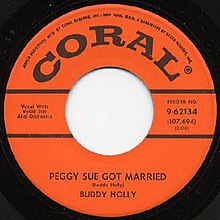Peggy Sue Got Married (song)
 From Wikipedia the free encyclopedia
From Wikipedia the free encyclopedia
This article includes a list of general references, but it lacks sufficient corresponding inline citations. (August 2016) |
| "Peggy Sue Got Married" | ||||
|---|---|---|---|---|
 | ||||
| Single by Buddy Holly | ||||
| B-side | "Crying, Waiting, Hoping" | |||
| Released |
| |||
| Recorded | New York City, December 8, 1958 | |||
| Genre | Rock and roll | |||
| Length | 2:04 | |||
| Label | Coral | |||
| Songwriter(s) | Buddy Holly | |||
| Producer(s) | Jack Hansen | |||
| Buddy Holly singles chronology | ||||
| ||||
"Peggy Sue Got Married" is a song written and performed by Buddy Holly. It was posthumously released in July 1959 as a 45-rpm single with "Crying, Waiting, Hoping". It refers to his 1957 hit song "Peggy Sue". It was one of the first sequels of the rock era.
Buddy Holly version[edit]
Buddy Holly recorded the vocal, accompanying himself on guitar, on December 8, 1958, in apartment 4H of "The Brevoort" on New York City's Fifth Avenue. Record producer Jack Hansen prepared Holly's solo recording for commercial release. The Ray Charles Singers recorded backup vocals, and studio musicians recorded an instrumental arrangement on June 30, 1959, at Coral Records' Studio A in New York. In 1964, Holly's former producer Norman Petty recorded an alternate version of the song, with new instrumentals (by The Fireballs) but without backup singers.
The studio recording sessions and overdubs for "Peggy Sue Got Married" were similar to those for the posthumous track "Crying, Waiting, Hoping". Buddy Holly's original, undubbed home recording was used as theme music in the film Peggy Sue Got Married.
The Crickets version[edit]
After Buddy Holly had died in a plane crash on February 3, 1959, the Crickets recorded their own version in June 1959.[1] David Box, a native of Lubbock, Texas, and a Buddy Holly soundalike, joined the group as lead vocalist for this version of "Peggy Sue Got Married" which was released in the United States as the B-side of Coral 62238 in 1960. The Crickets had decided to use the original arrangements they had used for "Peggy Sue" with the only change being David Box on lead vocal.[2]
Other cover versions[edit]
This section may require cleanup to meet Wikipedia's quality standards. The specific problem is: versions may not meet WP:SONGCOVER. (June 2018) |
- Rikki Henderson released his recording of "Peggy Sue Got Married" in 1959 as an Embassy Records 45 single.
- South African Roger Smith recorded the song in 1962 in a version released on the Twistin' Wild album.
- Fleetwood Mac recorded a version of the song in 1968 featuring Peter Green for BBC Radio One.
- The Beatles performed the song at the 1969 Get Back/Let It Be sessions in 1969 in a medley with "Maybe Baby" with John Lennon on lead vocals.
- The Hollies recorded a version using Buddy Holly's vocals from the December 5, 1958 demo take joined by returning member Graham Nash as part of the Not Fade Away tribute.
- John Doe recorded a version of the song that was included on the 2011 compilation album Rave On Buddy Holly.
- In July 2015, the British record label Rollercoaster Records released a high-tech remix by Chris Hopkins.
References[edit]
- ^ "Who's Who On The Cricket's Recordings". Rockin50s.com. Archived from the original on 2013-02-11. Retrieved 2016-08-29.
- ^ Peggy Sue Gerron; Glenda Cameron (1960-08-11). Whatever Happened to Peggy Sue?: A Memoir by Buddy Holly's Peggy Sue. AuthorHouse. p. 134. ISBN 9780980008517. Retrieved 2016-08-29.
Sources[edit]
- Amburn, Ellis (1996). Buddy Holly: A Biography. St. Martin's Press. ISBN 978-0-312-14557-6
- Bustard, Anne (2005). Buddy: The Story of Buddy Holly. Simon & Schuster. ISBN 978-1-4223-9302-4
- Dawson, Jim; Leigh, Spencer (1996). Memories of Buddy Holly. Big Nickel Publications. ISBN 978-0-936433-20-2
- Gerron, Peggy Sue (2008). Whatever Happened to Peggy Sue?. Togi Entertainment. ISBN 978-0-9800085-0-0
- Goldrosen, John; Beecher, John (1996). Remembering Buddy: The Definitive Biography. New York: Da Capo Press. ISBN 0-306-80715-7
- Goldrosen, John (1975). Buddy Holly: His Life and Music. Popular Press. ISBN 0-85947-018-0
- Gribbin, John (2009). Not Fade Away: The Life and Music of Buddy Holly. London: Icon Books. ISBN 978-1-84831-034-6